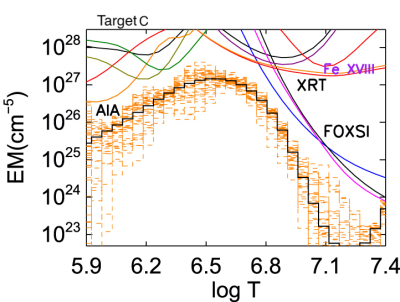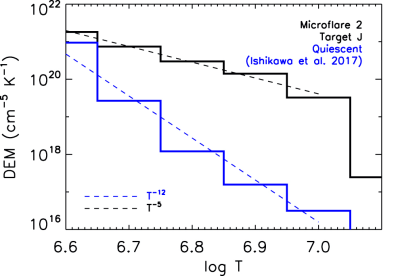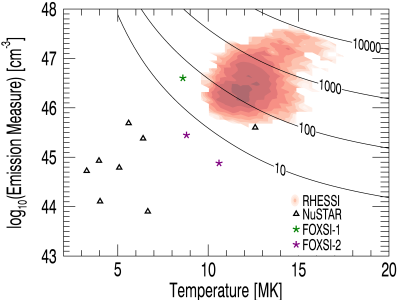Investigation of Small-Scale Energy Releases in Hard X-rays with FOXSI
| Nugget | |
|---|---|
| Number: | 396 |
| 1st Author: | Subramania ATHIRAY |
| 2nd Author: | Juliana VIEVERING |
| Published: | 7 December 2020 |
| Next Nugget: | TBD |
| Previous Nugget: | What drives impulsive coronal heating? |
Introduction
Investigation of small-scale energy releases in the solar corona with enhanced sensitivity and imaging dynamic range can be achieved by using focusing hard X-ray optics, which offer a narrow point spread function (PSF) and high signal-to-noise ratio due to the reduction in detector area. In 2012, the Focusing Optics X-ray Solar Imager (FOXSI) sounding rocket experiment first demonstrated the power of direct focusing optics for imaging solar HXRs, observing over the energy range 4-15 keV and achieving a sensitivity ~10 times greater than that of RHESSI (Ref. [1]). To date, FOXSI has had three successful flights and has been funded for a fourth launch, scheduled for 2024.
FOXSI-2 microflare observations
The second FOXSI flight (FOXSI-2), with upgraded instrumentation, was successfully launched on 11 December 2014 from the White Sands Missile Range, New Mexico. During its flight, FOXSI-2 observed two sub-A class microflares from two active regions, AR 12230 and AR 12234. This flight was coordinated with several other instruments including the X-ray Telescope (XRT) onboard Hinode, the Interface Region Imaging Spectrograph (IRIS) and the Atmospheric Imaging Assembly (AIA) onboard the Solar Dynamics Observatory (SDO), which observes the full Sun most of the time.
Multi-thermal Differential Emission Measure
This Nugget describes a combined analysis of the microflares observed with the FOXSI-2 flight. This analysis centers on the differential emission measure (DEM), which characterizes the distribution of plasma emission as a function of temperature. Here we make use of the imaging spectroscopy from FOXSI-2 5-6 keV, 6-7 keV, 7-8 keV channels, selected XRT channels (the Be-Med, Be-thin, Al-Med, C-poly, Ti-poly), and AIA (94, 131, 171, 193, 211Å) - three independent and complementary views of the flaring plasmas. These taken together provide unprecedented temperature coverage and compose a good overlap in temperature sensitivity. The resulting microflare DEMs peak around 3 MK and exhibit significant emission above 5 MK.
A well-constrained emission measure (EM) for the microflare from AR 12230 (Figure 1) along with EM loci curves show that FOXSI-2 can better constrain the high temperature emission than using SDO/AIA and Hinode/XRT alone. At log T > 6.7, only the FOXSI-2 flux actually defines the distribution. The contribution above 5 MK is more than two orders of magnitude lower than that of the main component, and at 10 MK is more than three to four orders lower. The other two telescopes (AIA and XRT) simply cannot observe these contributions.

Comparison of the DEM during the quiescent and flaring phases for AR 12234 (Figure 2) indicates a change in the high-temperature slope of the distribution. The decrease of the EM slope from T-12 to T-4 (logT = 6.6 to 7.0) during flare times clearly shows the contribution of hot plasma emission above 5 MK. Using these well-determined DEMs, we calculated the comprehensive thermal energy estimates for the microflares, which are found to be ~1028 erg, around the energy at which RHESSI's sensitivity starts to limit the fraction of observed events.
HXR Imaging Spectroscopy
In addition to the multi-thermal DEM analysis described in Ref. [2], we harness the enhanced capabilities of FOXSI-2 to perform the first direct imaging spectroscopy of solar HXRs with an angular resolution (~9 arc sec) at size scales relevant for microflares (Ref. [3]).
Through spectral analyses of the two FOXSI-2 microflares using an optically thin isothermal plasma model, we find evidence for plasma heated to temperatures (T) of ~10 MK and emission measures (EM) down to ~1044 cm-3. Comparing these results to microflares observed by other HXR instruments (Figure 3), we note that one of the microflares observed by FOXSI-2 is roughly an order of magnitude fainter than the faintest events studied with RHESSI. Additionally, FOXSI-2's sensitivity to higher temperature plasmas complements NuSTAR's sensitivity to lower temperature plasmas.
Examining FOXSI-2 images of the first microflare (AR 12230) in two energy bands during the third flight target (Target C), we find the centroid of the higher-energy emission (6-15 keV) to be east of the low-energy centroid (4-5.5 keV), suggesting higher plasma temperatures toward the eastern part of this flare. With the deconvolved FOXSI-2 images shown in Figure 4, we see that this higher-energy emission extends out towards a small eastern feature that is brightening in AIA 94 during this time interval, whereas the lower-energy emission is concentrated on the dominant middle feature. This combined data set (additional time intervals shown in Ref. [3]) provides compelling evidence for multiple energy releases during this sub-A class flare, indicating that it more closely resembles the complex structure and dynamics of a large flare rather than the single energy release of a nanoflare.

Conclusions
As the first solar-dedicated direct HXR spectroscopic imager, FOXSI provides unprecedented capabilities for studying small-scale solar events. The main take-aways from the FOXSI-2 microflare analyses include:
1. The coordinated FOXSI-2 microflare observations produce one of the few definitive measurements of the distribution and the amount of plasma above 5 MK in two sub A-class microflares, showing that these small-scale energy releases have significant emission above 5 MK.
2. Direct imaging spectroscopy of FOXSI-2 microflare data reveals evidence of complex energy release for events down to this small size, indicating that they are more similar in evolution to large flares than to nanoflares.
References
[1] "First Images from the Focusing Optics X-ray Solar Imager"
[3] "FOXSI-2 Solar Microflares. II. Hard X-ray Imaging Spectroscopy and Flare Energetics"

